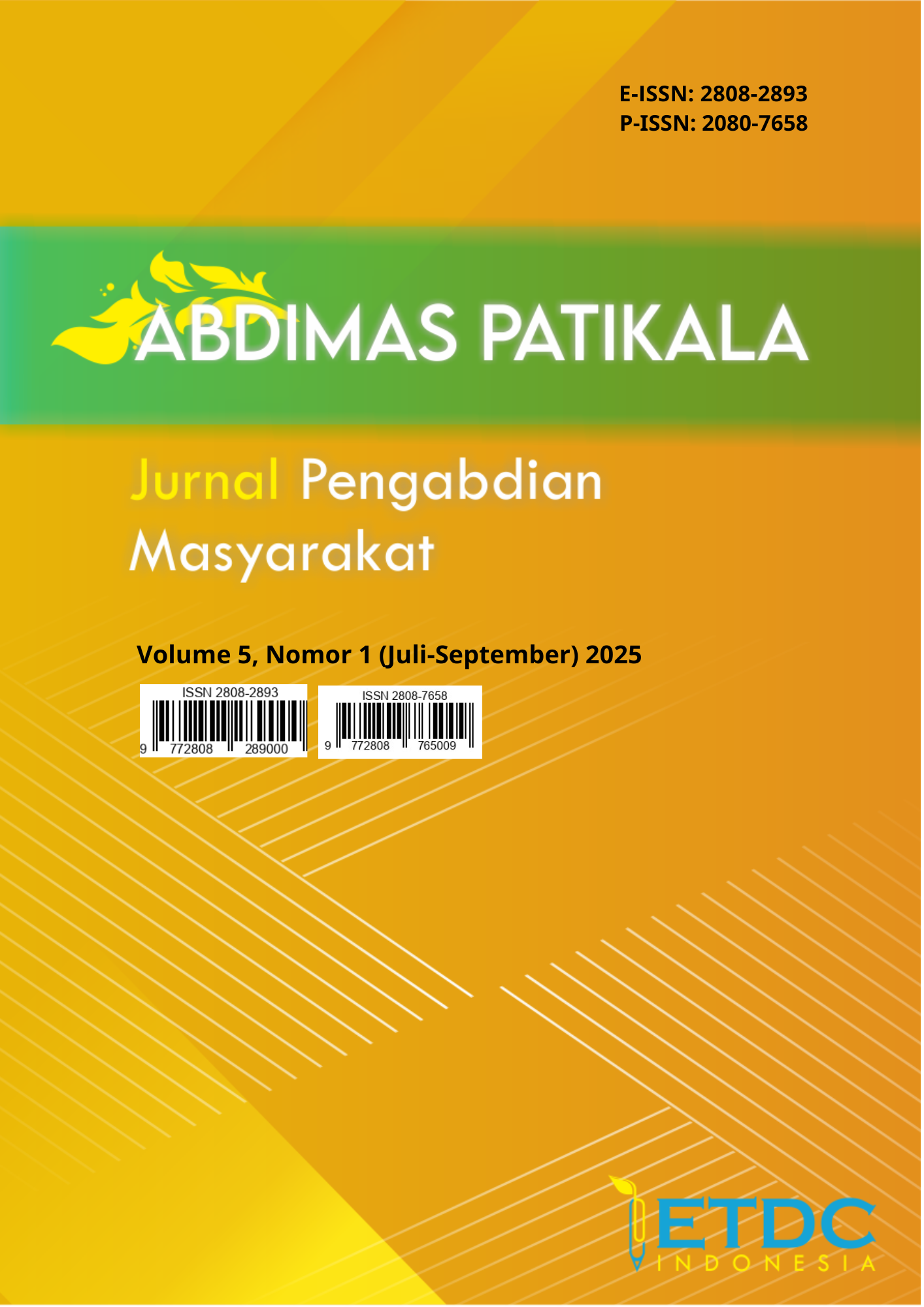Pelatihan Pengembangan Media Pembelajaran Berbasis Wordwall Di UPT SMP Negeri 2 Bontonompo
https://doi.org/10.51574/patikala.v5i1.3619
Keywords:
Learning Media, Wordwall, Merdeka Curriculum, Teacher Training, Digital LiteracyAbstract
This training program was initiated due to the limited ability of teachers to develop interactive digital-based learning media aligned with the Merdeka Curriculum. The objective was to enhance teachers’ competence in designing and utilizing Wordwall-based media to support engaging and participatory classroom activities. The training was conducted in both offline and online modes at UPT SMP Negeri 2 Bontonompo, involving 13 teachers. The implementation included lectures, demonstrations, Wordwall creation practices, and mentoring. Evaluation was carried out using pretest and posttest instruments, as well as quality analysis of the developed media. The results indicated a significant improvement in scores, rising from an average of 14.92 (pretest) to 20.38 (posttest), with a Sig. < 0.05. All participants successfully produced one Wordwall-based media relevant to their teaching topics. This activity significantly contributed to improving teachers' skills in integrating technology into instruction and strengthening their digital pedagogical capacity. The program serves as a viable model for ongoing training aimed at promoting technology-integrated learning in schools.
Downloads
References
Almuafa, H. A. & Alqurashi, H. S. (2025). The impact of using wordwall interactive games on english vocabulary acquisition: Evidence from Saudi Arabia. International Journal of Linguistics, 17(2), 64–79. https://doi.org/10.5296/ijl.v17i2.22685
Anderson, T. (2020). The theory and practice of online learning (2nd ed.). Athabasca University Press. https://www.aupress.ca/books/120146-the-theory-and-practice-of-online-learning/
Arifin, I. & Manda, D. (2024). The effectiveness of wordwall in increasing student engagement in elementary social studies education course at west sulawesi university. Pinisi Journal of Social Science, 2(3): 119-127. https://doi.org/10.26858/pjss.v2i3.62298
Aulia, H., Hafeez, M., Mashwani, H. U., Careemdeen, J. D., Mirzapour, M., & Syaharuddin. (2024). The role of interactive learning media in enhancing student engagement and academic achievement. International Seminar on Student Research in Education, Science, and Technology. https://www.researchgate.net/publication/380103660_The_Role_of_Interactive_Learning_Media_in_Enhancing_Student_Engagement_and_Academic_Achievement
Azhar, A. (2015). Media pembelajaran: Fungsi dan peranannya dalam proses pembelajaran. Rajawali Pers.
Marensi, V., Suarman, & Syahza, A. (2023). The effectiveness of using word wall-based learning media in increasing students’ learning activities on economy learning subjects at SMA PGRI Pekanbaru. Jurnal PAJAR (Pendidikan dan Pengajaran), 7(2), 407–415. http://dx.doi.org/10.33578/pjr.v7i2.9165
Mayer, R. E. (2009). Multimedia learning (2nd ed.). Cambridge University Press. https://doi.org/10.1017/CBO9780511811678
Mazelin, N., Maniam, M., Jeyaraja, S. S. B., Ng, M. M., Xiaoqi, Z., & Jingjing, Z. (2022). Using Wordwall to improve students’ engagement in ESL classroom. International Journal of Asian Social Science, 12(8), 273–280. https://doi.org/10.55493/5007.v12i8.4558
Safitri, D., Awalia, S., Sekaringtyas, T., Nuraini, I., & Lestari, I. (2022). Improvement of student learning motivation through word-wall-based digital game media. International Journal of Interactive Mobile Technologies (iJIM), 16(06): 188-205. https://doi.org/10.3991/ijim.v16i06.25729
Sahronih, S., Purwanto, A., & Sumantri, M. S. (2020). The effect of use interactive learning media environment-based and learning motivation on science learning outcomes. International Journal for Educational and Vocational Studies, 2(3), 640–647. https://doi.org/10.29103/ijevs.v2i3.2429
Scalise, K., Wilson, M., & Gochyyev, P. (2021). A Taxonomy of Critical Dimensions at the Intersection of Learning Analytics and Educational Measurement. Front. Educ. 6:656525. https://doi.org/10.3389/feduc.2021.656525
Sweller, J., Ayres, P., & Kalyuga, S. (2011). Cognitive load theory. Springer. https://doi.org/10.1007/978-1-4419-8126-4
VanLehn, K. (2011). The relative effectiveness of human tutoring, intelligent tutoring systems, and other tutoring systems. Educational Psychologist, 46(4), 197–221. https://doi.org/10.1080/00461520.2011.611369
Zubaidah, S. (2016). Keterampilan abad 21: Kebutuhan dalam pengembangan pembelajaran. Seminar Nasional Pendidikan, 1(1), 1–17. http://pasca.um.ac.id/conferences/index.php/snpasca/article/view/14
Downloads
Published
How to Cite
Issue
Section
License
Copyright (c) 2025 Jurnal Pengabdian Kepada Masyarakat Patikala

This work is licensed under a Creative Commons Attribution-ShareAlike 4.0 International License.
















